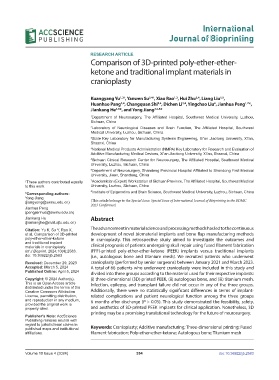Page 362 - IJB-10-4
P. 362
International
Journal of Bioprinting
RESEARCH ARTICLE
Comparison of 3D-printed poly-ether-ether-
ketone and traditional implant materials in
cranioplasty
Kuangyang Yu 1,2† , Yanwen Su 3,4† , Xiao Rao , Hui Zhu , Liang Liu ,
1,5
3,4
1,2
Huanhao Pang , Changquan Shi , Dichen Li , Yingchao Liu , Jianhua Peng *,
1,7
3,4
6
3,4
3,4
Jiankang He *, and Yong Jiang 1,2,8 *
3,4
1 Department of Neurosurgery, The Affiliated Hospital, Southwest Medical University, Luzhou,
Sichuan, China
2 Laboratory of Neurological Diseases and Brain Function, The Affiliated Hospital, Southwest
Medical University, Luzhou, Sichuan, China
3
State Key Laboratory for Manufacturing Systems Engineering, Xi’an Jiaotong University, Xi’an,
Shaanxi, China
4 National Medical Products Administration (NMPA) Key Laboratory for Research and Evaluation of
Additive Manufacturing Medical Devices, Xi’an Jiaotong University, Xi’an, Shaanxi, China
5 Sichuan Clinical Research Center for Neurosurgery, The Affiliated Hospital, Southwest Medical
University, Luzhou, Sichuan, China
6 Department of Neurosurgery, Shandong Provincial Hospital Affiliated to Shandong First Medical
University, Jinan, Shandong, China
† These authors contributed equally 7 Academician (Expert) Workstation of Sichuan Province, The Affiliated Hospital, Southwest Medical
to this work. University, Luzhou, Sichuan, China
*Corresponding authors: 8 Institute of Epigenetics and Brain Science, Southwest Medical University, Luzhou, Sichuan, China
Yong Jiang
(jiangyong@swmu.edu.cn) (This article belongs to the Special Issue: Special Issue of International Journal of Bioprinting in the BDMC
2023 Conference)
Jianhua Peng
(pengjianhua@swmu.edu.cn)
Jiankang He Abstract
(jiankanghe@mail.xjtu.edu.cn)
Citation: Yu K, Su Y, Rao X, The advancement in material science and processing methods has led to the continuous
et al. Comparison of 3D-printed development of novel biomaterial implants and bone flap manufacturing methods
poly-ether-ether-ketone in cranioplasty. This retrospective study aimed to investigate the outcomes and
and traditional implant
materials in cranioplasty. clinical prognosis of patients undergoing skull repair using fused filament fabrication
Int J Bioprint. 2024;10(4):2583. (FFF)-printed poly-ether-ether-ketone (PEEK) implants versus traditional implants
doi: 10.36922/ijb.2583 (i.e., autologous bone and titanium mesh). We recruited patients who underwent
Received: December 29, 2023 cranioplasty (performed by senior surgeons) between January 2021 and March 2023.
Accepted: March 5, 2024 A total of 66 patients who underwent cranioplasty were included in this study and
Published Online: April 5, 2024 divided into three groups according to the material used for their respective implants:
Copyright: © 2024 Author(s). (i) three-dimensional (3D)-printed PEEK, (ii) autologous bone, and (iii) titanium mesh.
This is an Open Access article Infection, epilepsy, and transplant failure did not occur in any of the three groups.
distributed under the terms of the
Creative Commons Attribution Additionally, there were no statistically significant differences in terms of implant-
License, permitting distribution, related complications and patient neurological function among the three groups
and reproduction in any medium, 6 months after discharge (P > 0.05). This study demonstrated the feasibility, safety,
provided the original work is
properly cited. and aesthetics of 3D-printed PEEK implants for clinical application. Nonetheless, 3D
printing may be a promising translational technology for the future of neurosurgery.
Publisher’s Note: AccScience
Publishing remains neutral with
regard to jurisdictional claims in
published maps and institutional Keywords: Cranioplasty; Additive manufacturing; Three-dimensional printing; Fused
affiliations. filament fabrication; Poly-ether-ether-ketone; Autologous bone; Titanium mesh
Volume 10 Issue 4 (2024) 354 doi: 10.36922/ijb.2583

